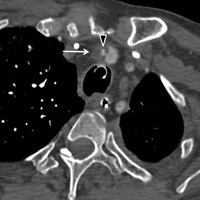 Smart Citations
Smart CitationsSee how this article has been cited at scite.ai
scite shows how a scientific paper has been cited by providing the context of the citation, a classification describing whether it supports, mentions, or contrasts the cited claim, and a label indicating in which section the citation was made.
Thrombosis of the innominate artery during prolonged cardiac support by right transaxillary Impella 5.0 device
We describe an unexpected complication in a 46-years-old man affected by ischemic cardiomyopathy who received a prolonged mechanical cardiac support by means of right transaxillary Impella 5.0. The postoperative course was complicated by recurrent septicemia from multi-durg resistant Acinetobacter baumanii. He underwent implantation of venoarterial extracorporeal membrane oxygenation because of refractory cardiac arrest, followed by Impella removal that has been complicated by embolic stroke. The likely source of the embolus was a large thrombus inside the innominate artery. After a long-standing right transaxillary device implantation, particularly in patients with intercurrent septic episodes, a CT angiographic scan should be planned to exclude arterial thrombosis before removal of the transarterial device.
How to Cite
PAGEPress has chosen to apply the Creative Commons Attribution NonCommercial 4.0 International License (CC BY-NC 4.0) to all manuscripts to be published.

 https://doi.org/10.4081/ecj.2021.9123
https://doi.org/10.4081/ecj.2021.9123





